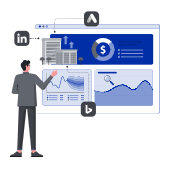Discover the best B2B SEM tools for lead generation. This guide covers Google Ads, LinkedIn Ads, SEMrush, and more to help you optimize your campaigns and drive results.
In the competitive world of B2B Search Engine Marketing (SEM), having the right tools is essential for driving high-quality leads and maximizing ROI. From keyword research to campaign management, the right tools can streamline your efforts, improve targeting, and boost conversions. But with so many options available, choosing the best tools for your needs can be overwhelming.
In this blog, we’ll explore the best B2B SEM tools for lead generation. Whether you’re a seasoned marketer or just starting out, these tools will help you optimize your campaigns and achieve your business goals. Let’s dive in!
Why B2B SEM Tools Matter for Lead Generation
B2B SEM tools are more than just a convenience—they’re a necessity. Here’s why they’re crucial for lead generation:
- Efficiency: Automate repetitive tasks and save time.
- Precision: Target the right audience with advanced targeting options.
- Insights: Gain data-driven insights to optimize your campaigns.
- Scalability: Manage multiple campaigns and scale your efforts effectively.
In short, the right tools can make or break your B2B SEM success.
Top B2B SEM Tools for Lead Generation
Here are the best tools to supercharge your B2B SEM efforts:
1. Google Ads
- What It Does: Google Ads is the go-to platform for running search and display campaigns.
- Key Features: Keyword targeting, automated bidding, performance tracking.
- Best For: Driving traffic and conversions through search and display ads.
- Pro Tip: Use Google’s Performance Planner to forecast campaign performance and optimize your budget.
2. LinkedIn Ads
- What It Does: LinkedIn Ads allow you to target professionals by job title, industry, and company size.
- Key Features: Sponsored Content, InMail, lead gen forms.
- Best For: Reaching decision-makers and generating high-quality leads.
- Pro Tip: Use LinkedIn’s Matched Audiences to retarget website visitors or upload a list of contacts.
3. SEMrush
- What It Does: SEMrush is an all-in-one SEO and SEM tool for keyword research, competitive analysis, and campaign management.
- Key Features: Keyword research, ad copy suggestions, performance tracking.
- Best For: Optimizing campaigns and staying ahead of competitors.
- Pro Tip: Use SEMrush’s Position Tracking tool to monitor your rankings and adjust your strategy.
4. HubSpot
- What It Does: HubSpot is a comprehensive marketing platform that integrates SEM with CRM, email marketing, and more.
- Key Features: Campaign management, lead tracking, analytics.
- Best For: Managing end-to-end marketing campaigns and nurturing leads.
- Pro Tip: Use HubSpot’s Campaigns Tool to track the performance of your SEM efforts alongside other marketing activities.
5. Unbounce
- What It Does: Unbounce is a landing page builder designed to optimize conversions.
- Key Features: Drag-and-drop builder, A/B testing, dynamic text replacement.
- Best For: Creating high-converting landing pages for your SEM campaigns.
- Pro Tip: Use Unbounce’s Smart Traffic feature to automatically route visitors to the best-performing landing page.
6. OptinMonster
- What It Does: OptinMonster is a lead generation tool that helps you capture leads through pop-ups, forms, and more.
- Key Features: Exit-intent pop-ups, A/B testing, analytics.
- Best For: Increasing conversions and capturing leads on your website.
- Pro Tip: Use OptinMonster’s MonsterLinks to turn any text or image into a lead capture form.
7. ZoomInfo
- What It Does: ZoomInfo is a B2B database that provides contact information for decision-makers.
- Key Features: Firmographic data, contact details, intent data.
- Best For: Prospecting and targeting high-value accounts.
- Pro Tip: Use ZoomInfo’s Intent Data to identify accounts actively searching for solutions like yours.
8. Google Analytics
- What It Does: Google Analytics tracks website traffic and user behavior.
- Key Features: Conversion tracking, audience insights, campaign performance.
- Best For: Measuring the effectiveness of your SEM campaigns.
- Pro Tip: Set up Google Analytics Goals to track specific actions like form submissions or purchases.
9. Hotjar
- What It Does: Hotjar provides insights into user behavior through heatmaps, session recordings, and surveys.
- Key Features: Heatmaps, session recordings, feedback polls.
- Best For: Understanding how users interact with your website and improving conversions.
- Pro Tip: Use Hotjar’s Funnel Analysis to identify drop-off points in your conversion process.
10. Canva
- What It Does: Canva is a graphic design tool for creating eye-catching visuals.
- Key Features: Templates, drag-and-drop editor, stock images.
- Best For: Designing ad creatives and landing page visuals.
- Pro Tip: Use Canva’s Brand Kit to maintain consistent branding across all your designs.
How to Choose the Right Tools for Your Business
With so many options available, choosing the right tools can be challenging. Here’s how to make the best decision:
1. Define Your Goals
- Identify your primary objectives, such as lead generation, brand awareness, or website traffic.
2. Assess Your Budget
- Consider the cost of each tool and how it fits into your overall marketing budget.
3. Evaluate Integration
- Ensure the tools you choose integrate seamlessly with your existing tech stack.
4. Read Reviews
- Check user reviews and case studies to understand the pros and cons of each tool.
Pro Tip: Take advantage of free trials or demos to test tools before committing.
Conclusion
The right B2B SEM tools can transform your lead generation efforts, helping you reach the right audience, optimize your campaigns, and drive conversions. From Google Ads and LinkedIn Ads to SEMrush and Unbounce, these tools offer the features and functionality you need to succeed in the competitive B2B landscape.
Remember, the key to success is not just having the right tools but using them effectively. Regularly monitor performance, test new strategies, and refine your approach to stay ahead of the competition. With the right tools and strategies, you can turn your B2B SEM efforts into a significant driver of growth and success. You can contact us for a B2B SEM plan; we will handle everything for you.












